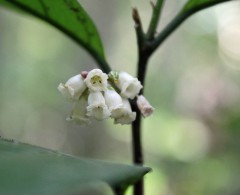New breed of orchid discovered in Takae district of Higashi

In March 2013, a new variety of orchid found growing in Takae. It is considered to be a form of saprophytic orchid (photograph taken by Chosei Tamaki).
April 21, 2013 Jun Kinjo of Ryukyu Shimpo
On April 20, Chosei Tamaki, the head of the Move Through Nature of Yambaru Association, an environmental non-governmental organization, confirmed the presence in the forest of the Takae district of Higashi of rare species of plants such as an orchid newly discovered in Taiwan last year and Maesa japonica, a type of shrub included on the critically endangered category of the IUCN Red List of Threatened Species. Tamaki called for the preservation of these valuable natural resources, saying, “The U.S. military plans to construct helipads in Takae, but the district preserves nature unique to the Yambaru area of the northern part of Okinawa, and its flora could even be termed a ‘museum’ of rare species.”

Maesa japonica photographed in 2009. It appears to be established in the forest of Takae (Photograph taken by Chosei Tamaki).
Although the presence of Maesa japonica has been reported for two places in Okinawa, it is highly likely that it has since become extinct in one of them. Takae will be the third place where the plant is found.
In 2009 Tamaki confirmed the presence of Maesa japonica for the first time. Since then, he has seen it blossom every year and he thinks that the plant is established in Takae.
To begin with, some experts judged the newly discovered orchid to be Gastrodia nipponica because of the similarity of its nature and shape, but Yokota pointed out that the plant is a new variety of orchid.
In addition to these, Tamaki confirmed the presence of several endangered species in the forests of Takae such as Taeniophyllum glandulosum and the ghost orchid.
With regard to the discovery of the new orchid, Tamaki said, “I was really surprised. I want to use this opportunity to make the Okinawan people aware of the need to protect this valuable forest.”
Yokota pointed out that the three factors such as 1) the extinction of autogenesis ground due to exploitation, 2) plant collecting and 3) natural calamities and pests could cause the extinction of these plants. Tamaki referred to the significance of protecting the native habitat of the forest from exploitation and other threats, saying, “Exploitation of autogenesis ground reduces the number of many species, but because the number and the autogenesis ground of animals and plants in Okinawa is limited to start with most are threatened by the factors just mentioned.”
(English translation by T&CT, Mark Ealey)
Previous Article:Ryukyu Shimpo and University of the Ryukyus start newspaper course
Next Article:Head of Iwaki Fisheries Cooperative studies sea urchin breeding in Okinawa
[Similar Articles]
- Discovery of new orchid in Yambaru reported in international journal
- Mystical, endangered orchid blooms in Nago City
- Three rare butterfly species photographed in Takae on same day
- Rare butterfly spotted around planned site for US helipad in Takae
- A walk through vibrant forest along Arakawa gawa and Fun gawa
 Webcam(Kokusai Street)
Webcam(Kokusai Street)


